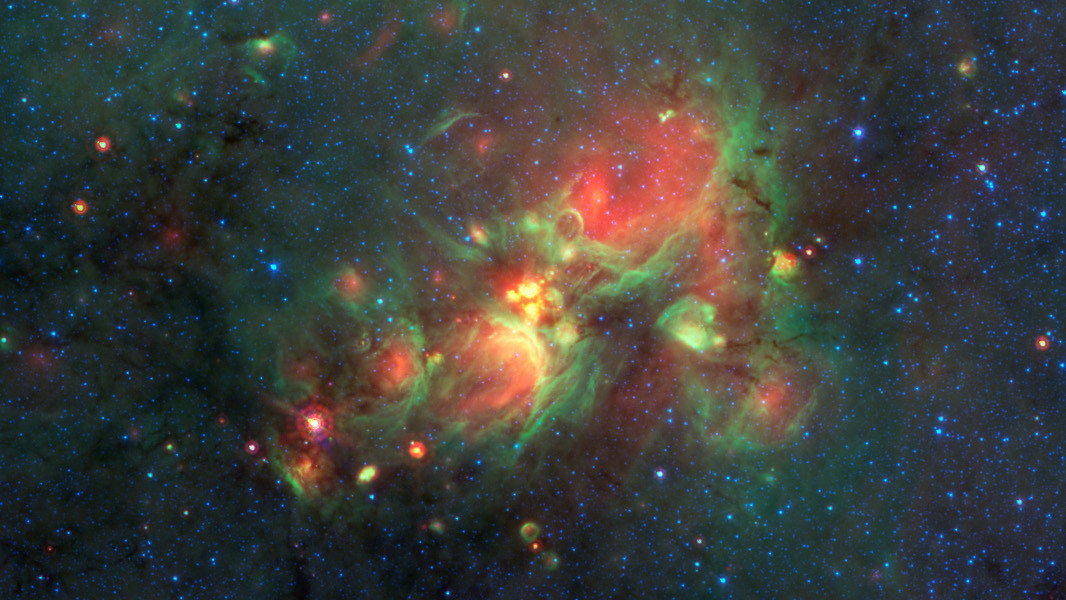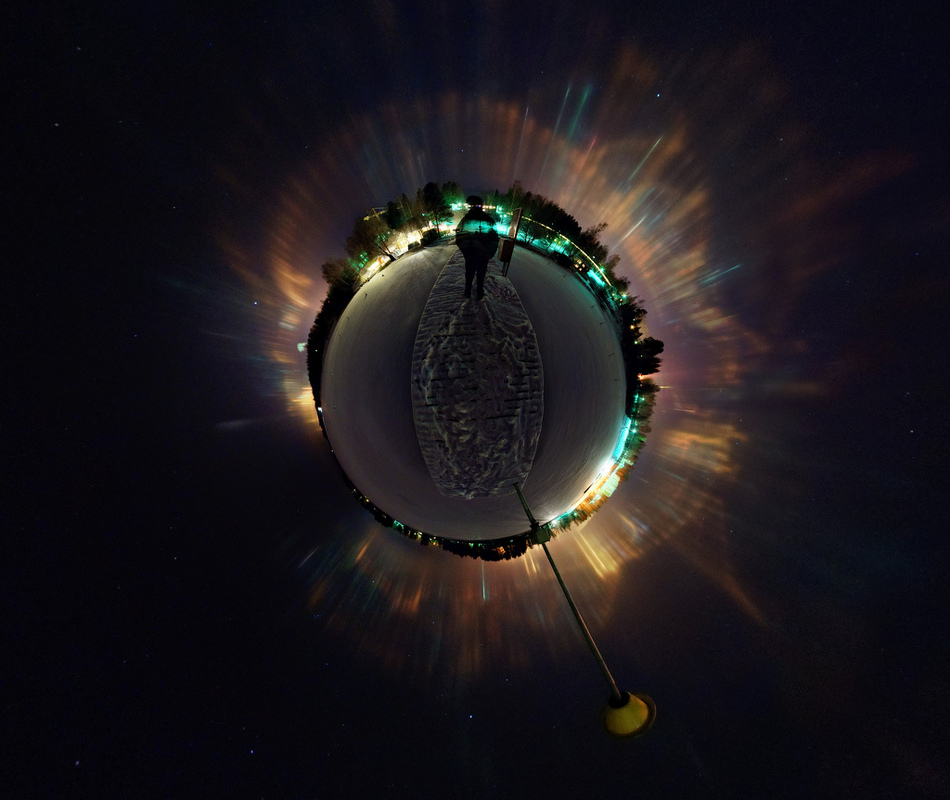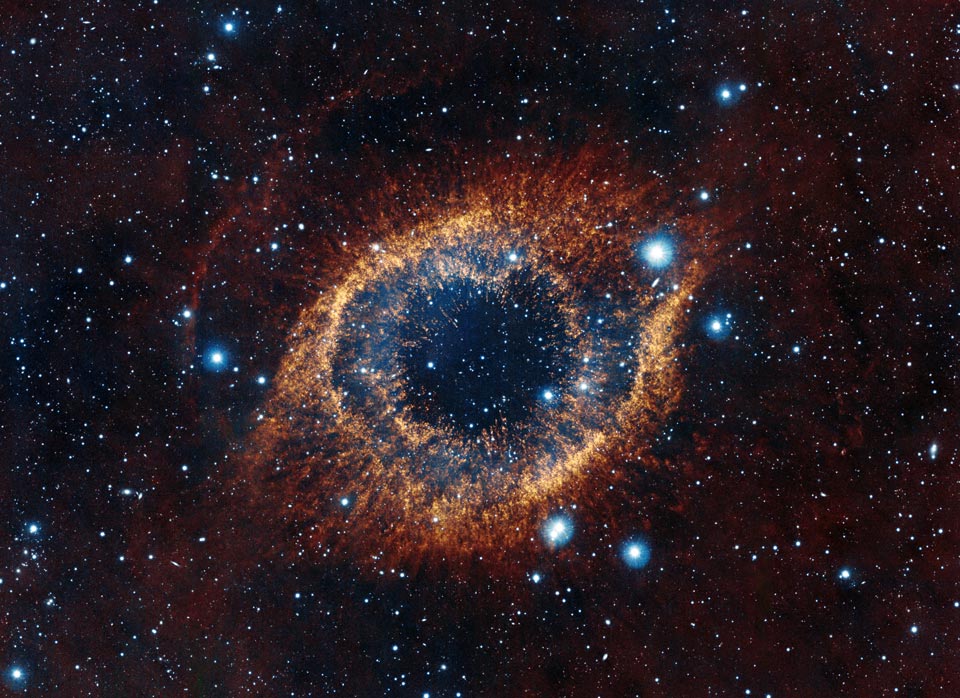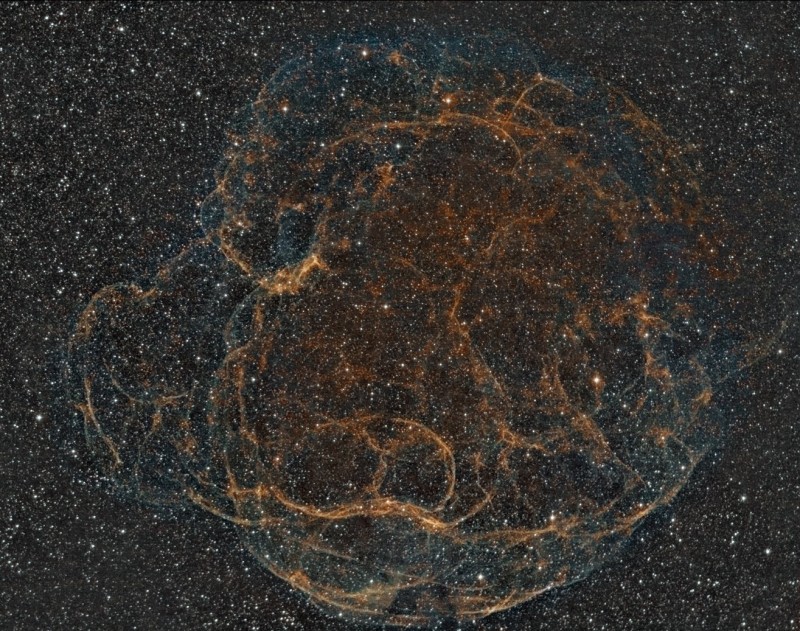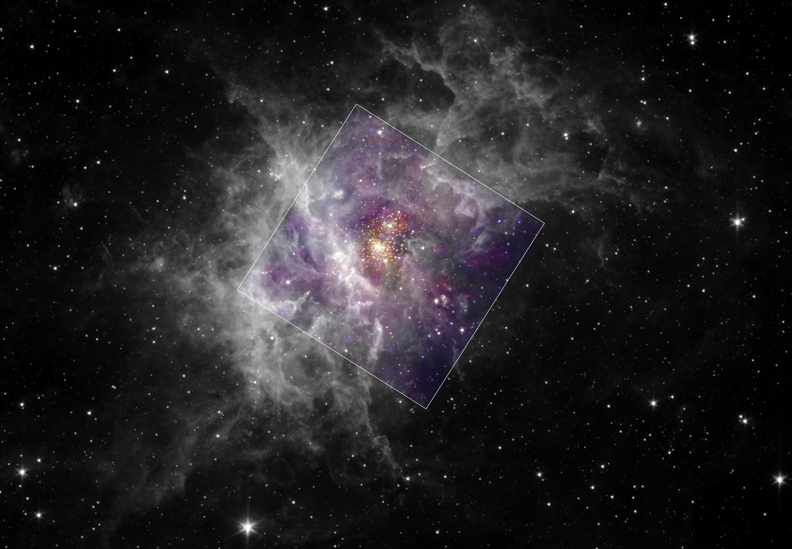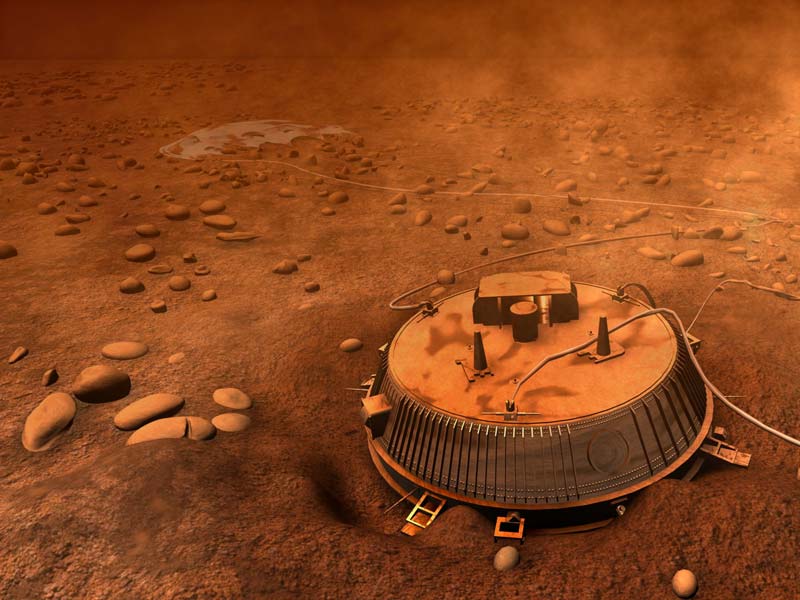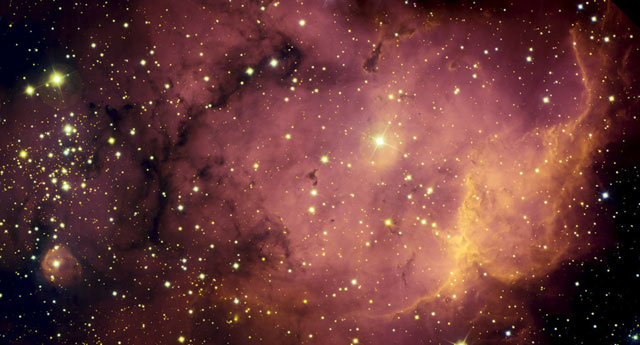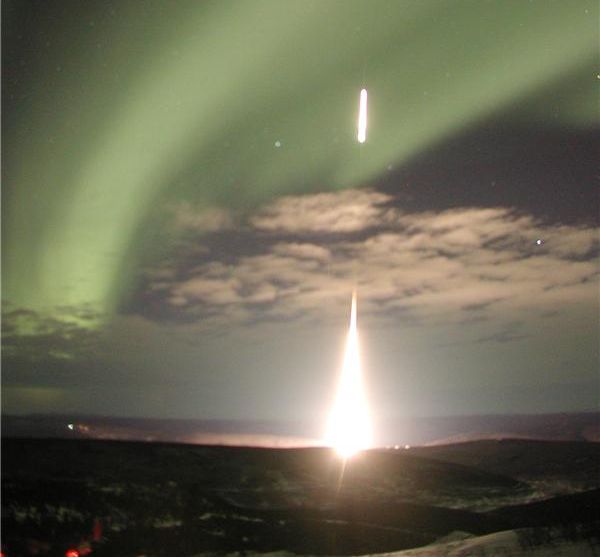| << Previous | Index | Next >> |
2015 Infrared wavelengths of 3.6, 8.0, and 24.0 microns observed by the Spitzer Space Telescope are mapped into visible colors red, green, and blue in this striking image. The cosmic cloud of gas and dust is W33, a massive starforming complex some 13,000 light-years distant, near the plane of our Milky Way Galaxy. So what are all those yellow balls? Citizen scientists of the web-based Milky Way Project found the features they called yellow balls as they scanned many Spitzer images and persistently asked that question of researchers. Now there is an answer. The yellow balls in Spitzer images are identified as an early stage of massive star formation. They appear yellow because they are overlapping regions of red and green, the assigned colors that correspond to dust and organic molecules known as PAHs at Spitzer wavelengths. Yellow balls represent the stage before newborn massive stars clear out cavities in their surrounding gas and dust and appear as green-rimmed bubbles with red centers in the Spitzer image. Of course, the astronomical crowdsourcing success story is only part of the Zooniverse. The Spitzer image spans 0.5 degrees or about 100 light-years at the estimated distance of W33.
2014 Eerie pillars of light ring the edges of this snowy little planet. Of course the little planet is planet Earth, shown in a nadir-to-zenith, around-the-horizon, little planet projection. The spherical panoramic image mosaic maps a view from Siilinjärvi in eastern Finland. Flat ice crystals, like those more often found in high, thin clouds, are gently fluttering in very cold air near the surface. Pillars of light appear as the crystals' briefly horizontal facets reflect upward directed light from ground sources downward, toward the observer. In fact, the fluttering crystals produce an effect analogous to shimmering columns of moonlight or sunlight reflected by surface waves across water.
2013 The delightful Dark Doodad Nebula drifts through southern skies, a tantalizing target for binoculars in the constellation Musca, The Fly. The dusty cosmic cloud is seen against rich starfields just south of the prominent Coalsack Nebula and the Southern Cross. Stretching for about 3 degrees across this scene the Dark Doodad seems punctuated at its southern tip (lower left) by globular star cluster NGC 4372. Of course NGC 4372 roams the halo of our Milky Way Galaxy, a background object some 20,000 light-years away and only by chance along our line-of-sight to the Dark Doodad. The Dark Doodad's well defined silhouette belongs to the Musca molecular cloud, but its better known alliterative moniker was first coined by astro-imager and writer Dennis di Cicco in 1986 while observing comet Halley from the Australian outback. The Dark Doodad is around 700 light-years distant and over 30 light-years long.
2012 Will our Sun look like this one day? The Helix Nebula is one of brightest and closest examples of a planetary nebula, a gas cloud created at the end of the life of a Sun-like star. The outer gasses of the star expelled into space appear from our vantage point as if we are looking down a helix. The remnant central stellar core, destined to become a white dwarf star, glows in light so energetic it causes the previously expelled gas to fluoresce. The Helix Nebula, given a technical designation of NGC 7293, lies about 700 light-years away towards the constellation of the Water Bearer (Aquarius) and spans about 2.5 light-years. The above picture was taken three colors on infrared light by the 4.1-meter Visible and Infrared Survey Telescope for Astronomy (VISTA) at the European Southern Observatory's Paranal Observatory in Chile. A close-up of the inner edge of the Helix Nebula shows complex gas knots of unknown origin.
2011 The care package from Earth had arrived. Last week, Japan launched the robotic Kounotori2 spacecraft to bring needed supplies, including food, to the International Space Station (ISS). Kountori2 launched from Japan's Tanegashima Space Center a little over a week ago reached the ISS in low Earth late last week. Pictured above, Kountori2 approached the ISS and was about to be grabbed by astronauts with the Canadarm2 and attached to the Harmony Module. In the above picture as seen through a window on the ISS, the limb of the Earth is visible, including white clouds, blue water, and various tan colored landforms. In addition to launches including humans, as many as ten robotic spacecraft may be launched to the space station this year, potentially including spacecraft from Russia, Europe, Japan, and a private company in the USA.
2010 The ancient text has no known title, no known author, and is written in no known language: what does it say and why does it have many astronomy illustrations? The mysterious book was once bought by an emperor, forgotten on a library shelf, sold for thousands of dollars, and later donated to Yale. Possibly written in the 15th century, the over 200-page volume is known most recently as the Voynich Manuscript, after its (re-)discoverer in 1912. Pictured above is an illustration from the book that appears to be somehow related to the Sun. The book labels some patches of the sky with unfamiliar constellations. The inability of modern historians of astronomy to understand the origins of these constellations is perhaps dwarfed by the inability of modern code-breakers to understand the book's text. Can the eclectic brain trust of APOD readers make any progress? If you think you can provide any insight, instead of sending us email please participate in a fresh online discussion. The book itself remains in Yale's rare book collection under catalog number "MS 408."
2009 It's easy to get lost following the intricate filaments in this detailed image of faint supernova remnant Simeis 147. Also cataloged as Sh2-240 and seen towards the constellation Taurus, it covers nearly 3 degrees (6 full moons) on the sky. That corresponds to a width of 150 light-years at the stellar debris cloud's estimated distance of 3,000 light-years. The remarkable narrow-band composite image in the Hubble color palette includes emission from hydrogen, sulfur, and oxygen atoms tracing regions of shocked, glowing gas. This supernova remnant has an estimated age of about 40,000 years - meaning light from the massive stellar explosion first reached Earth 40,000 years ago. But this expanding remnant is not the only aftermath. The cosmic catastrophe also left behind a spinning neutron star or pulsar, all that remains of the original star's core.
2008
2007 What would the rings of Saturn look like if you passed right through the ring plane? To find out, NASA aimed cameras from the Cassini spacecraft right at Saturn's rings as the robotic explorer passed from the sunlit side of the rings to the shadowed side. Resulting images from a vantage point outside the rings and most moons, but inside the orbit of Titan, have been gathered together in the above time-lapse movie. The dramatic movie demonstrates that ring particle density and reflectivity makes some parts of the shadowed side nearly the photographic negative of the sunlit side, but nearly empty regions remain continually dark. Visible also are Saturn-orbiting moons Enceladus, Mimas, Janus, Epimetheus, Prometheus, and Pandora. The extreme thinness of Saturn's rings can be appreciated from frames taken near the crossing time. (Animation here.
2006 If you could stand on Titan, what might you see? About one year ago the robotic Huygens probe landed on the enigmatic moon of Saturn and sent back the first ever images from beneath Titan's thick cloud layers. From the images sent back, an artist's impression of Huygens on Titan's surface has been reconstructed. In the foreground of the above image sits the car-sized lander that sent back images for more than 90 minutes before running out of battery power. The parachute that slowed Huygen's re-entry is seen in the background, attached to the lander by strong cords. Strange light smooth stones possibly containing water-ice are visible surrounding the landing craft. Analyses of Huygen's images and data shows that Titan's surface today has intriguing similarities to the surface of the early Earth.
2005 One might guess that the group of stars on the left is responsible for shaping the gas cloud on the right -- but it probably is not. Observations of many of the stars in the NGC 2467 show them to be more a superposition of loose groups of stars at different distances than a coherent open cluster of stars energizing the nebula. Still, the above image captures various stages of star formation. The stars at the far left have already formed and their birth nebulae have already dispersed. At the lower left lies a very young star that is breaking free of its surrounding birth cocoon of gas. On the right of the above image, a bright wall of bright gas glows as it evaporates from the energy of many newly formed bright stars. Toward the center, deep dark lanes of dust hide parts of the nebula that surely are forming new stars. The 8-meter Gemini South Telescope, perched on a mountaintop in Cerro Pachon, Chile, took the above image. NGC 2467 lies toward the southern constellation of Puppis, with many of the stars being about 17,000 light years distant.
2004 This gorgeous galaxy and comet portrait was recorded on April 5th, 2002, in the skies over the Oriental Pyrenees near Figueres, Spain. From a site above 1,100 meters, astrophotographer Juan Carlos Casado used a guided time exposure, fast film, and a telephoto lens to capture the predicted conjunction of the bright Comet Ikeya-Zhang (right) and the Andromeda Galaxy (left). This stunning celestial scene would also have been a rewarding one for the influential 18th century comet hunter Charles Messier. While Messier scanned French skies for comets, he carefully cataloged positions of things which were fuzzy and comet-like in appearance but did not move against the background stars and so were definitely not comets. The Andromeda Galaxy, also known as M31, is the 31st object in his famous not-a-comet catalog. Not-a-comet object number 110, a late addition to Messier's catalog, is one of Andromeda's small satellite galaxies, and can be seen here just below M31. Our modern understanding holds that the Andromeda galaxy is a large spiral galaxy some 2 million light-years distant. The photogenic Comet Ikeya-Zhang, then a lovely sight in early morning skies was about 80 million kilometers (4 light-minutes) from planet Earth.
2003 In this striking image, a rocket climbs skyward toward an expansive green auroral display in the first launch of 2003 from the University of Alaska's Poker Flat Research Range. Recorded on January 27th, the view from Cleary Summit near Fairbanks, Alaska shows the fiery tracks of both solid fuel stages of the Black Brant IX sounding rocket that lofted its payload to an altitude of 385 kilometers. Compared to rockets which launch payloads to Earth orbit and beyond, sounding rockets are small and relatively inexpensive. They get their generic name from the nautical term "to sound" which means to take measurements. Known as HIBAR (HIgh Bandwidth Auroral Rocket), this experiment was designed to measure aurora related high-frequency plasma waves which may originate thousands of kilometers above the aurora's visible glow.
2002 The stars beyond the Sun and the distant galaxies should be undetectable at extreme ultraviolet wavelengths. At least that was the conventional wisdom when it was first realized that the space between the stars is filled with hydrogen, a strong absorber of extreme ultraviolet light. But this idea was seriously questioned as it became apparent that interstellar hydrogen was patchy in its distribution and the quest to explore the extreme ultraviolet sky culminated in 1992 with the launch of the EUVE (Extreme UltraViolet Explorer) spacecraft. An all-sky map, based on the satellite's first six months of operation, appears above showing brightness variations in the EUV sky in false color (north is up). EUVE's scanning by orbit gives the picture a striped look while other instrument artifacts are seen as crosses and data gaps are dark. Multiple images of the Moon combine to form the short, bright dashed lines wandering along the middle of the picture. The belt stars of the familiar constellation Orion are fairly easy to make out left of picture center. EUVE's science operations ceased in 2001 but it ultimately detected nearly 1,000 celestial objects, including over three dozen outside our own galaxy. EUVE's voyage of discovery is now complete, and the spacecraft re-entered the Earth's atmosphere yesterday at approximately 11:15 p.m. EST.
2001 Our Earth is surrounded by plasma. The overall shape that this ionized gas plasmasphere takes was discovered last year by NASA's robot IMAGE spacecraft, and shown in the recently released above image in ultraviolet light. The arm of the plasmasphere pointing toward the Sun, on the lower right, was hypothesized but never before seen directly. The Earth's shadow can be seen pointing away from the Sun. The bright regions in the center are full auroral rings over northern Earth, visible as northern lights from the ground. The plasmasphere is thought created by sunlight energizing molecules in Earth's upper atmosphere and is contained by Earth's magnetic field. IMAGE continues to study how solar magnetic storms affect Earth and its magnetic field.
2000 Earth is an ocean planet. From low Earth orbit, the Sea-viewing Wide Field-of-view Sensor (SeaWiFS) instrument onboard NASA's SeaStar spacecraft globally maps ocean color, tracking changes in the climate and biosphere of our water world. Richly detailed SeaWiFS images can also follow color changes in Earth's landmasses as illustrated in this close-up picture of the planet. Taken on January 27, it covers the Great Lakes region and Atlantic coastal areas of the North American continent. The space-based perspective splendidly reveals the extent of fractal white seasonal solid phase H20 recently sprinkled over the Northeastern and Midatlantic US. Unanticipated and intense, the snowstorm delighted school children but caused serious disruptions in many locales.
1999 Welcome to Planet Earth, the third planet from a star named the Sun. The Earth is shaped like a sphere and composed mostly of rock. Over 70 percent of the Earth's surface is water. The planet has a relatively thin atmosphere composed mostly of nitrogen and oxygen. Earth has a single large Moon which is about 1/4 of its diameter and, from the planet's surface, is seen to have almost exactly the same angular size as the Sun. With its abundance of liquid water, Earth supports a large variety of life forms, including potentially intelligent species such as dolphins and humans. Please enjoy your stay on Planet Earth.
1998 What's in a name? Since 1919, the International Astronomical Union has been charged with the task of establishing "conventional" nomenclature for planets, satellites, and surface features. For the remote Uranian system of moons, namesakes from Shakespearean works have been chosen. Thus Oberon, king of the mid-summer night fairies, is also Uranus' most distant and second largest moon. Hamlet is the tragically dark, large and princely crater on its surface (right of center). The above image represents known surface features of Oberon and was constructed by the U.S. Geological Survey (USGS) based on data from NASA's robot explorer Voyager 2. In 1986, Voyager 2 flew through the Uranian system - so far it has been the only spacecraft to do so.
1997 What's in a name? Since 1919, the International Astronomical Union has been charged with the task of establishing "conventional" nomenclature for planets, satellites, and surface features. For the remote Uranian system of moons, namesakes from Shakespearean works have been chosen. Thus Oberon, king of the mid-summer night fairies, is also Uranus' most distant and second largest moon and Hamlet is a tragically large and princely crater on its surface. The above image represents known surface features of Oberon and was constructed by the U.S. Geological Survey (USGS) based on data from NASA's robot explorer Voyager 2. Hamlet is the large dark crater to the right of center. In 1986, Voyager 2 flew through the Uranian system - so far it has been the only spacecraft to do so.
1996 Do many Sun-like stars have planets? Speculation on this point has been ongoing since humanity's realization that other stars existed. Only in the past year, however, have answers and discoveries been realized. The above plot summarizes the four known cases of normal stars having planets. These cases are: our Solar System, 51 Pegasi, 70 Virgini, and 47 Ursae Majoris. The later two cases were discovered by astronomers led by Geoff Marcy and Paul Butler as part of a greater project inspecting 120 stars for orbiting planets. Interestingly enough, the planets around the later two stars have temperatures in the right range to allow liquid water - and hence may have conditions ripe for the development of life.
| << Previous | Index | Next >> |
